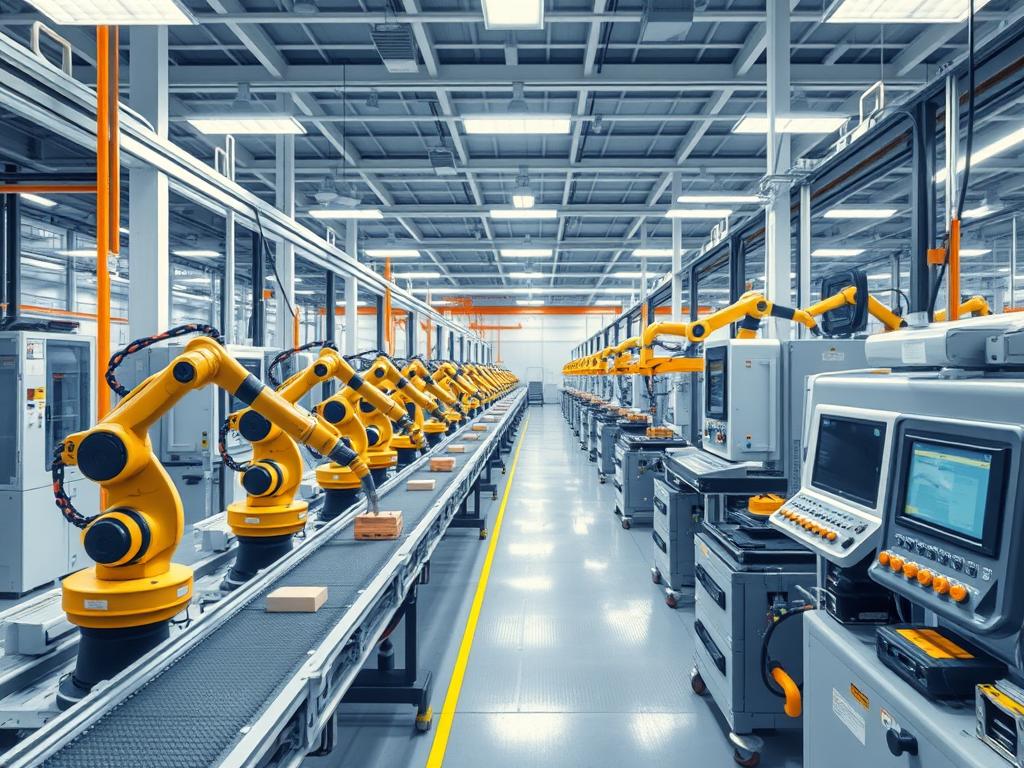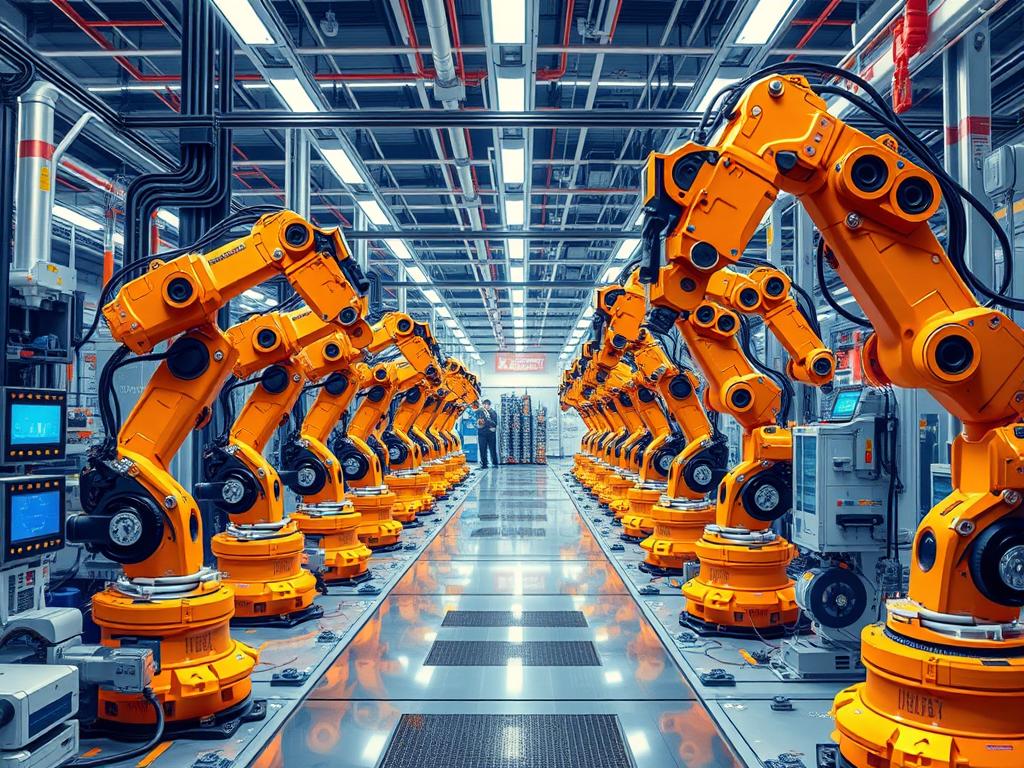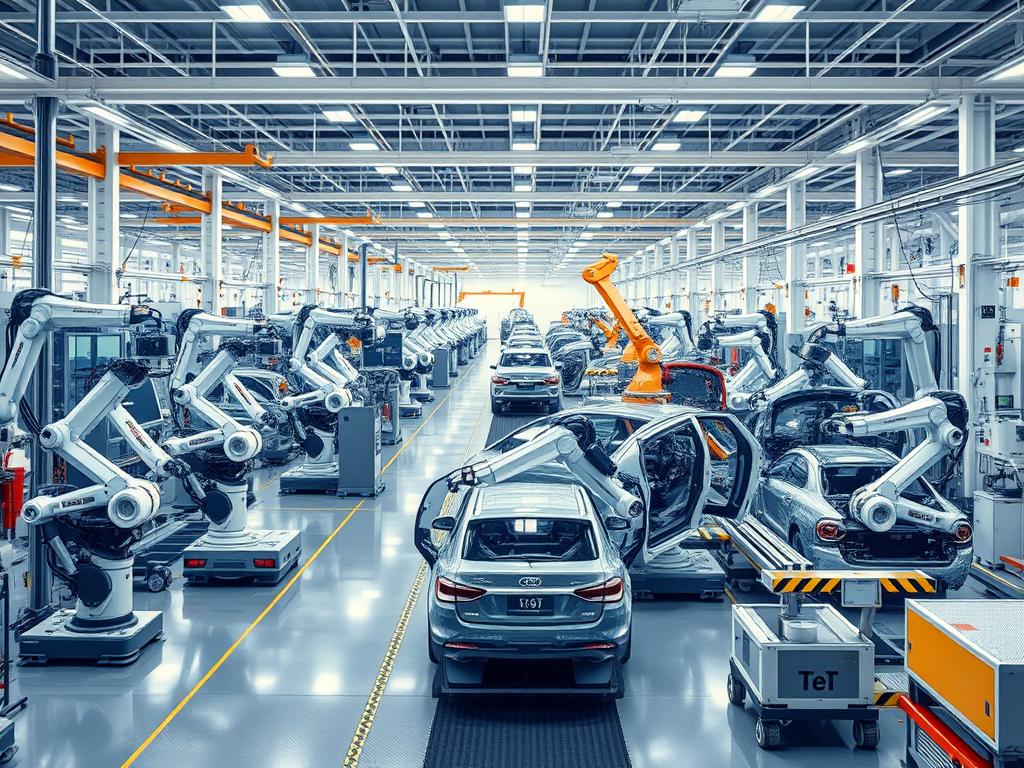Industrial robots have grown from 700,000 in 1997 to over 3 million in 2020. This growth highlights programmable automation’s crucial role in modern manufacturing. It’s revolutionizing industries, boosting efficiency, and cutting costs.
Industrial automation began with the 18th-century Industrial Revolution. Henry Ford’s 1913 assembly line transformed production processes. Today, we’re in Industry 4.0, where smart systems optimize production using IoT, AI, and machine learning.
Programmable automation leads this industrial evolution, offering unmatched manufacturing flexibility. It uses computers and robots to control processes and machinery. This reduces human involvement while boosting productivity.
This technology shines in low-volume production or for products with short life cycles. It helps manufacturers quickly adapt to market changes and stay competitive.
Key technologies driving programmable automation include Programmable Logic Controllers (PLCs) and advanced robotics. Pulse-width modulation and other control techniques are vital in these systems. Let’s explore how programmable automation is changing manufacturing.
Understanding Programmable Automation and Its Importance
Programmable automation systems boost manufacturing efficiency and flexibility. They control industrial robots and equipment with precision. These systems can be reprogrammed for different products, unlike fixed automation methods.
Definition and Overview
Programmable automation uses computer-controlled systems in manufacturing. These systems offer unmatched manufacturing flexibility compared to fixed automation. They can be quickly reconfigured to produce various items.
Programmable logic controllers (PLCs), sensors, and actuators work together in these systems. They execute complex production sequences efficiently and accurately.

Key Differences from Fixed and Flexible Automation
Programmable systems allow product changes through software updates, unlike fixed automation. This adaptability requires some downtime for reconfiguration. Flexible automation offers greater adaptability with shorter changeover times.
Programmable automation balances flexibility and efficiency. It’s ideal for small to medium batch production in various industries.
| Automation Type | Flexibility | Production Volume | Changeover Time |
|---|---|---|---|
| Fixed | Low | High | Long |
| Programmable | Medium | Medium | Medium |
| Flexible | High | Low to Medium | Short |
The industrial automation market was worth $191 billion in 2021. It’s projected to reach $395 billion by 2029. This growth shows programmable automation’s rising importance in modern manufacturing.
The Role of Programmable Automation in Modern Manufacturing
Programmable automation reshapes modern manufacturing. It balances flexibility with efficiency in production. This technology adapts to changing product demands, ideal for medium-volume production runs.
Enhancing Production Efficiency
Programmable automation boosts manufacturing efficiency significantly. It reduces human error and minimizes waste, ensuring consistent output standards. The automotive industry uses this technology to assemble different car models on one production line.
This versatility allows manufacturers to optimize operations without increasing overhead costs. It provides a cost-effective solution for diverse production needs.

| Aspect | Programmable Automation | Fixed Automation | Flexible Automation |
|---|---|---|---|
| Production Volume | Medium | High | Low to Medium |
| Flexibility | Moderate | Low | High |
| Initial Investment | Moderate | High | High |
| Speed | Moderate | High | Variable |
Reducing Operational Costs
Programmable automation offers significant long-term automation benefits. It reduces setup costs for multiple products by eliminating new equipment needs. This technology enables 24/7 production, shortening lead times and meeting customer demands effectively.
Production optimization through programmable automation lowers operational costs. It cuts labor and waste expenses while maintaining high quality standards. The precision of these systems results in fewer defects, enhancing cost efficiency.
“Programmable automation is the key to balancing flexibility and efficiency in modern manufacturing.”
In electronics and textiles, programmable automation adapts quickly to market changes. It allows faster responses to product variations. This keeps manufacturers competitive in dynamic markets.
Practical Applications of Programmable Automation
Programmable automation transforms manufacturing across many industries. It adapts to various production needs, boosting efficiency and precision. This technology enhances multiple sectors with its versatile capabilities.
Automotive Industry Implementations
Automotive automation revolutionizes vehicle production. Programmable systems control welding robots, paint application, and assembly lines. These systems allow quick retooling for new car models, increasing flexibility and output.

Electronics Assembly Processes
Electronics manufacturing depends on programmable automation for precision. Automated systems place and solder components on circuit boards. This technology ensures accuracy in producing smartphones, computers, and other electronic devices.
Food and Beverage Production
Food processing automation improves safety and consistency. Programmable systems control mixing, packaging, and quality inspection. These applications maintain hygiene standards in large-scale food production.
| Industry | Application | Benefits |
|---|---|---|
| Automotive | Welding, Painting, Assembly | Flexibility, Increased Output |
| Electronics | Component Placement, Soldering | Precision, Consistency |
| Food & Beverage | Mixing, Packaging, Inspection | Hygiene, Quality Control |
These examples highlight programmable automation’s adaptability in manufacturing. It drives efficiency and quality in producing cars, circuit boards, and food products. This technology continues to shape various manufacturing sectors.
Key Technologies Driving Programmable Automation
Programmable automation is changing how we make things. It uses new technologies to improve production. These innovations make manufacturing faster and better.
Programmable Logic Controllers (PLCs)
PLCs are the heart of programmable automation systems. These tough computers manage factory processes with great accuracy. They read inputs, follow programmed steps, and control outputs for complex manufacturing.
Robotics and Automation Software
Industrial robots have changed production lines. Advanced robots use smart sensors to do tricky jobs perfectly. Automation software connects all parts of the system.
This software helps with programming and watching over everything. Together, robots and software make work faster and products better.
Internet of Things (IoT) Integration
IoT is a big deal in manufacturing. It collects data in real-time and lets you control systems from far away. AI-powered automation uses this data to make everything work better.
These technologies are making programmable automation smarter and more flexible. They help factories meet today’s production needs. The global industrial automation market is growing fast.
It’s expected to reach $395 billion by 2029. These new technologies will be crucial in shaping how we make things in the future.
Benefits of Implementing Programmable Automation
Programmable automation revolutionizes manufacturing processes. The global industrial automation market is booming, set to reach $178.10 billion this year. Let’s explore how this technology transforms modern factories.
Increased Flexibility and Scalability
Manufacturing flexibility is key in programmable automation. It allows quick adaptation to new product designs and production volumes. This programmable automation approach helps manufacturers scale operations efficiently.
Improved Quality Control
Quality control automation is a major benefit. Automated systems perform tasks with high precision, reducing errors. This leads to better products and happier customers.
It also cuts material waste and lowers rework costs. Robotic Assembly Cells work quickly and precisely, minimizing errors.
- Higher product quality
- Increased customer satisfaction
- Reduced material waste
- Lower rework costs
Enhanced Worker Safety
Workplace safety improves with programmable automation. Hazardous tasks are automated, reducing injury risks. Human workers can focus on complex tasks requiring judgment and problem-solving skills.
With 616,000 manufacturing job openings in August 2023, automation helps address labor shortages. It also creates safer work environments for employees.
Production scalability becomes easier with programmable systems. Manufacturers can adjust capacity swiftly and operate around the clock. This flexibility is crucial in today’s fast-paced market.
“Automation creates new jobs to supervise automated processes and allows remaining workers to focus on tasks that require human judgment and problem-solving skills.”
Programmable automation offers a powerful mix of benefits. It combines flexibility, quality control, safety, and scalability. These advantages help manufacturers thrive in the competitive global market.
Challenges and Considerations
Programmable automation in manufacturing offers great benefits. However, it also presents unique challenges. Companies must overcome these hurdles to fully utilize automation technologies.
Initial Investment and Budget Constraints
The upfront automation investment can be substantial. Companies need to assess their finances and plan for both short-term and long-term costs. These include hardware, software, infrastructure setup, and ongoing maintenance.
The total cost often goes beyond the initial purchase. It includes upgrades and technical support. A thorough ROI analysis is crucial to determine if automation is feasible.
Companies must balance current financial limits with future gains. This balance between cost and benefit is key when deciding on automation. The long-term benefits can be significant, but immediate costs must be considered.
Skills Gap and Worker Training Needs
Automated systems create demand for skilled labor, especially in maintenance and technical roles. Many industries face a significant skills gap. This poses a challenge for effective workforce development.
Companies must invest in thorough industrial training programs. These programs equip employees with skills to operate and maintain advanced automation systems.
| Challenge | Solution |
|---|---|
| Skills Gap | Invest in workforce development programs |
| Training Needs | Implement comprehensive industrial training |
| Job Displacement Concerns | Clear communication about evolving roles |
Addressing these technology implementation challenges requires strategy. Companies can use government-sponsored programs for cross-training their workforce. This ensures a smooth transition to automated systems.
“The future of industrial production lies in adaptive technologies and a skilled workforce capable of managing advanced automation systems.”
Future Trends in Programmable Automation
Programmable automation is changing fast due to new tech and market needs. Industries are going digital. This shift brings new ways to make things better and greener.
Integration of AI and Machine Learning
AI is set to change how we make things. Experts predict big growth in smart systems that learn and adapt. These systems can fix problems before they happen.
They also make production smoother. By 2030, AI might add $4.9 trillion yearly to industry output. This will change how factories work.
Sustainability and Green Manufacturing Practices
Making things in a green way is now a big deal. Smart systems help save energy and use resources better. They also make less waste.
This green shift helps the earth and saves money for businesses. It’s a win-win for everyone.
Global Market Outlook and Predictions
The world’s automation market is growing fast. It might reach $414.48 billion by 2030, growing 10% each year. The trend is moving towards flexible systems.
Companies are buying tech that can quickly change with the market. This helps them stay ahead in a fast-changing world.


